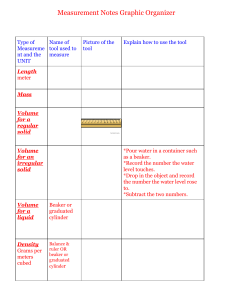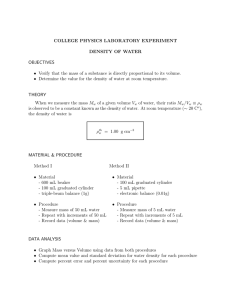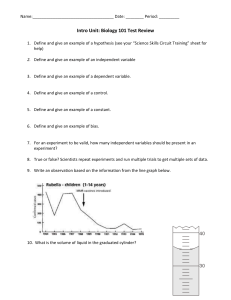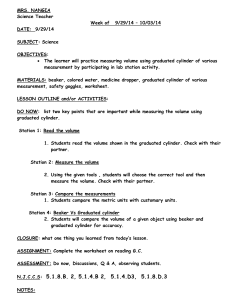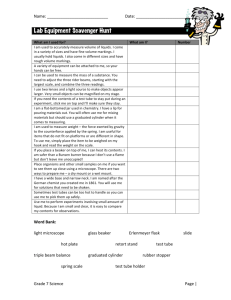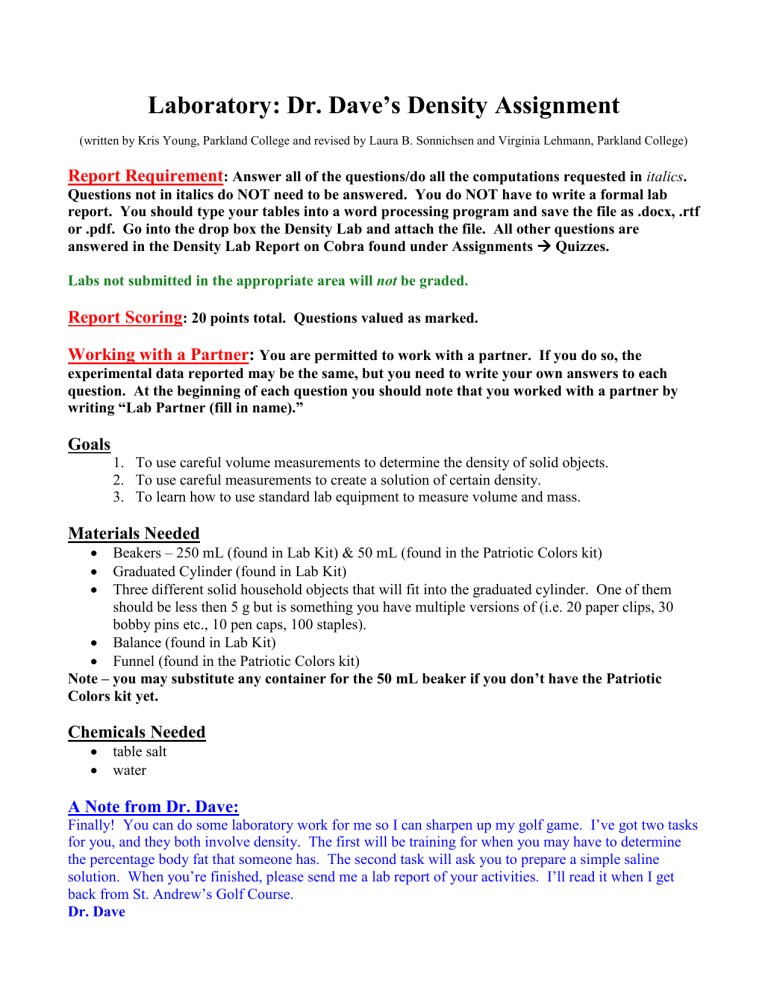
Laboratory: Dr. Dave’s Density Assignment (written by Kris Young, Parkland College and revised by Laura B. Sonnichsen and Virginia Lehmann, Parkland College) Report Requirement: Answer all of the questions/do all the computations requested in italics. Questions not in italics do NOT need to be answered. You do NOT have to write a formal lab report. You should type your tables into a word processing program and save the file as .docx, .rtf or .pdf. Go into the drop box the Density Lab and attach the file. All other questions are answered in the Density Lab Report on Cobra found under Assignments Quizzes. Labs not submitted in the appropriate area will not be graded. Report Scoring: 20 points total. Questions valued as marked. Working with a Partner: You are permitted to work with a partner. If you do so, the experimental data reported may be the same, but you need to write your own answers to each question. At the beginning of each question you should note that you worked with a partner by writing “Lab Partner (fill in name).” Goals 1. To use careful volume measurements to determine the density of solid objects. 2. To use careful measurements to create a solution of certain density. 3. To learn how to use standard lab equipment to measure volume and mass. Materials Needed Beakers – 250 mL (found in Lab Kit) & 50 mL (found in the Patriotic Colors kit) Graduated Cylinder (found in Lab Kit) Three different solid household objects that will fit into the graduated cylinder. One of them should be less then 5 g but is something you have multiple versions of (i.e. 20 paper clips, 30 bobby pins etc., 10 pen caps, 100 staples). Balance (found in Lab Kit) Funnel (found in the Patriotic Colors kit) Note – you may substitute any container for the 50 mL beaker if you don’t have the Patriotic Colors kit yet. Chemicals Needed table salt water A Note from Dr. Dave: Finally! You can do some laboratory work for me so I can sharpen up my golf game. I’ve got two tasks for you, and they both involve density. The first will be training for when you may have to determine the percentage body fat that someone has. The second task will ask you to prepare a simple saline solution. When you’re finished, please send me a lab report of your activities. I’ll read it when I get back from St. Andrew’s Golf Course. Dr. Dave Part I: Determining the Density of Objects (Similar to Body Fat Determinations) Determination of Body Fat Supplemental Reading (found in Cobra) describes how percentage body fat is determined. While it is obviously not practical to attempt this procedure at home, we can demonstrate the underlying principles. When a solid object is placed in a liquid, the object displaces the some of the volume of the liquid. Think about drawing a nice hot bath almost to the top of your tub. As you get in the tub all ready for the relaxation that the bath will bring, the water spills out of the tub! The volume that your body takes up has pushed an equivalent volume of water out of the way to make room for you! We can use this to our advantage to find density. If you know the volume of displaced liquid, you also know the volume of the object that displaced the liquid. If you also know the mass of the object…well, gee: the ratio of mass and volume gives you density!!! Procedure A. Setting up the equipment: Since this is the first lab, you will need to get familiar with your equipment. 1. Graduated cylinder: Must always be placed on a level surface. It is a 50 or 100-mL graduated cylinder, with 1 mL markings (measures to .1 mL) 2. Beakers: Must always be placed on a level surface. You should have both a 250 mL beaker (from the Lab Kit) and a 100 mL beaker (from the Patriotic Colors kit), with 10 mL markings. Beakers should never be used to measure volume. 3. Balance: Get the balance out of the box. Put the batteries (provided) in the balance. It should now be operational. To mass items – put balance on a flat surface and remove lid. Turn balance on and wait for it to register zero’s. Place your item on the balance surface and wait for the reading to stabilize for 3 seconds. This is the mass of your item. If you do not want to place your item directly on the balance surface, you can use the beaker as a balance pan. To do so, put the beaker on the balance and then hit on/tare. Wait until the mass is zero. Now, add your item and wait for the mass to Graduated stabilize. Never place more than 200g on your balance! Cylinder Balance 250 mL Beaker B. Part I – Measuring the density of solids When doing lab work, you should always be as careful and accurate as possible. For any measuring device with markings (such as a graduated cylinder or ruler), you must ALWAYS record the value one digit PAST the markings on your measuring device. For example, if your graduated cylinder has markings for each 1 mL, your data should be given to the tenth’s place – you must estimate where the line is between the markings! If it is right on the marking for 39, then it is 39.0, for example, but if it is a bit past, it might be considered to be at 39.3, for example (or maybe 39.5 or 39.7, depending on where it is). For digital measuring devices (like your balance), you will need to record all the digits displayed on the readout, but you will NOT estimate another digit. 1) Add about 25 mL of water to the graduated cylinder. Record the starting volume of the water. NOTE: To take volume measurements accurately, your eyes need to be at the same height as the top of the liquid. Don’t be looking down or up to read the volume measurement! Also, you liquid level should be read at the meniscus (the lowest point of the surface) and NOT at the edges. 2) Put the beaker on the balance to use as a balance pan, if needed. Zero the balance. 3) Find a household object with a mass of at least 5 g. (It is best to use a solid object that does not absorb water. Otherwise, you will get inaccurate results. And it must fit in your graduated cylinder and not mass more than 150 g.) 4) Put the object in the beaker on the balance and record the mass. 5) Place the object in the graduated cylinder. For accurate volumes, the object must be completely underwater. If you object floats, push it down with a small implement (such as an opened paper clip), so that it is underwater. Record the new volume of the water in the graduated cylinder. 6) If the water rose above the top measurement on the graduated cylinder, remove the object, then remove some of the water. Record the new starting volume of the water (replaces data from step #1) and repeat step #5. 7) Find a second household object that is more than 5 g, and repeat steps 1-6 for this object. 8) Find a third household object, this time one that is less than 5 g, but that you have multiple of 8) Repeat steps 1 – 6 for one of this third object. 9) Repeat steps 1-6 for multiple of your third object, making sure that you use enough to get a mass of more than 5 g. (10 g or more would be even better.) Question 1: (7 points) Prepare a table like the one shown below and fill in all of the information. Green text is hints on how to calculate the quantity. Only final values are needed – you don’t have to show your calculations in your report. Object 1 Object 2 Object 3 (one) Object 3 (multiple) (= final volume – starting volume) (= final volume – starting volume) (= final volume – starting volume) (= final volume – starting volume) What is it? Mass of object (in grams) Starting volume (in mL) Final volume (in mL) Volume of object (in mL) Calculated Density in g/mL Did it sink or float in water? C: Part II – Creating a 5.0% saline solution I.V. solutions are a combination of water and several dissolved substances including potassium chloride, dextrose, Ringer’s solution, and sodium chloride. Sodium chloride is the chemical name for common table salt. Many I.V. bags contain 0.9% mass per volume sodium chloride to water. In this lab, you will be asked to create a saline solution. The salt percentage will not match that of an I.V. bag, but the concept of solution preparation is the same. Since Dr. Dave has asked you to prepare a saline solution, you will do so by making a solution of sodium chloride and water. Mass to volume ratios are easy if you are preparing 100 mL of a solution. If you are told to make a 25% salt solution, you would dissolve 25 grams of salt into 100 mL of water. However, sometimes you will not want to make exactly 100 mL of solution, so you should know how to determine the mass needed for whatever volume of solution you wish to make. The following example shows how to make 500 mL of a 0.9% saline solution. Step 1: Change the percent to a decimal by moving the decimal point 2 places to the left. Step 2: Convert the volume to milliliters if needed. Step 3: Multiply the decimal in Step 1 by the volume in milliliters from Step 2 to get the mass of the sodium chloride needed. Place this mass in the measuring cup and fill to the desired volume from Step 2. Example: Prepare 500 mL of 0.9% I.V. saline solution. Step 1: 0.9% = 0.009 Step 2: not needed – already in mL: 500 mL Step 3: 500 x 0.009 = 4.5 g Place 4.5 grams of salt into a jug and add 500 mL of water. Remember for this lab, you are preparing a 5.0% saline solution. Making the solution You will create a sample of 5.0% saline solution. You will want to measure somewhere between 5 and 30 grams of salt. Be sure to pay attention to these guidelines. 1) Select a volume of solution you wish to prepare – you must make at least 100 mL of solution. 2) Perform a calculation similar to that shown above in order to determine how much salt you will need to mass in order to create a 5.0% saline solution. (You will need to change the percentage and volume values to what you are planning on using.) 3) Measure out this mass of salt on your balance (use the 250 mL beaker as a balance pan). Don’t forget to zero the balance with the beaker on it! 4) Remove the beaker from the balance, and then add the desired volume of water to beaker. Make sure that you use the graduated cylinder to measure the volume of water. If your salt does not dissolve readily, you may warm the water so that the salt goes into solution faster. HOWEVER, you must let the solution cool down to room temperature before going on to step 5. Note – if you do not have the 100 mL beaker, prepare the solution in another container (transfer salt to container before adding water). Your beaker will always be your balance pan. 5) You have created a 5.0% saline solution! You will now need to determine the density of the solution. 6) Transfer about 80 mL of your solution from your beaker to your graduated cylinder. Use the funnel to help transfer the solution without spilling. Record the exact volume in the graduated cylinder (this is your starting volume). 7) Zero your balance pan (use the 100 mL beaker). 8) Pour about 20 – 25 mL of your solution from the graduated cylinder into the balance pan. Record the mass. 9) Record the exact volume of solution left in the graduated cylinder (this is your final volume). 10) Clean and dry your balance pan. 11) Check the volume of solution in the graduated cylinder. Do you have at least 60 mL? If not, add more solution until you do. Record the exact volume in the graduated cylinder (this is your starting volume). 12) Zero your balance pan (use the 100 mL beaker). 13) Pour about 40 – 45 mL of your solution from the graduated cylinder into the balance pan. Record the mass. 14) Record the exact volume of solution left in the graduated cylinder (this is your final volume). 16) From the data collected in steps 6-9 & 11-14, compute the density of your solution in g/mL. Question #2 (4 points) Prepare a table like the one shown below and fill in all of the information. Starting volume (in mL) Trial #1 (from step #6) Trial #2 (from step #11) Mass of solution (in grams) (from step #8) (from step #13) Final volume (in mL) (from step #9) (from step #14) (= starting volume – final volume) (= starting volume – final volume) Final volume of solution in balance pan (in mL) Density of solution in g/mL Question 3: (1 point) What is the average density of the solution prepared in Part II? Show your work in calculating the average for full credit. Post Lab Questions Question 4: (1 point) What is wrong with this statement? "If the density of 1 paper clip is 1.5 g/mL, the density of 2 paper clips is 3.0 g/mL." (Assume they are the same size/type/brand of paper clip.) Question 5: (1 point) In part I, was the density you found for object 3 (less than 5 g) the same when you used one item as when you used multiple items? Should the density have been the same? Why or why not? Which method would you expect to be more accurate? Why? Question 6: (1 points) In Part II, you were asked to compute the average density of the saline solution using a portion of the solution. Can the density of the entire solution be measured from just a small sample of the solution? Explain your answer for full credit. Question 7: (1 point) In part II, you measured two separate portions of your saline solution. Should the density be the same for each portion? Explain your answer for full credit. (Note – This is what you should see in an ideal world, not necessarily what you did see.) Question 8: (1 point) Do your experimental results from part II support your answer in question 7? (make sure you restate whether the densities should be the same or not from Q7). Why or why not? Question 9: (1 point) List a possible source of experimental error for Part I. List a possible source of experimental error for Part II. Be specific for each error, and explain how the error would affect your calculated density. Note – Human error is not an acceptable answer. Question 10: (1 point) Does the fact that the object sank or floated support the density you found using your quantitative calculation? Why or why not? Explain your answer clearly and completely for each object. You should restate density values. Question 11: (1 point) Predict whether your objects (from Part I) will sink or float in a saline solution that has a density of 5 g/mL. Why or why not? Explain your answer clearly and completely for each object. You should restate density values. You should type your tables into a word processing program and save the file as .docx, .rft or .pdf. Go into the drop box the Density Lab and attach the file. All other questions are answered in the Density Lab Report on Cobra found under Assignments Quizzes. Labs not submitted in the appropriate area will not be graded. This lab was created by Kris Young and revised by Laura Sonnichsen and Virginia Lehmann. You are welcome to copy and distribute the lab so long as credit is given. Ver.012013
